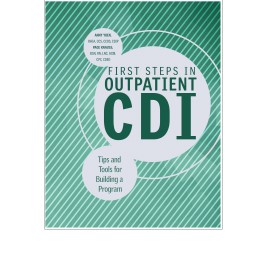Summer reading: Why is outpatient CDI necessary?

Tools for Building a Program
By Anny Yuen, RHIA, CCS, CCDS, CDIP, and Page Knauss, BSN, RN, LNC, ACM, CPC, CDEO
Advancements in medicine and technology shifted a variety of services that were once solely performed in the inpatient setting to the outpatient setting. The Medicare Payment Advisory Committee’s (MedPAC) Report to Congress in March 2013 demonstrated that from 2004 to 2011, outpatient services per beneficiary grew 34%, while inpatient admissions declined by 8% (MedPAC, 2013).
The agency’s 2016 report revealed a drastic shift to outpatient services since 2006. This analysis reflected a 44.2% increase in outpatient visits per fee-for-service Part B beneficiary compared to a 19.9% decrease in inpatient discharges per fee-for-service Part A beneficiary.
CMS pays for outpatient encounters under Medicare Part B, according to rules in the outpatient prospective payment system (OPPS). OPPS claims are processed using the Healthcare Common Procedure Coding System, which must support medical necessity for the services provided. CDI departments planning to expand their scope of practice to include physician services need a working knowledge of the payment methodologies associated with professional encounters. Such methodologies include the Medicare Physician Fee Schedule (MPFS) and evaluation and management coding, based on which physicians get paid, as well as ICD-10-CM/PCS.
Outpatient CDI is a broad concept and can describe any CDI effort not associated with an inpatient claim. The Medicare Benefit Policy Manual states the following:
Hospitals provide two distinct types of services to outpatients: services that are diagnostic in nature and other services that aid the physician in the treatment of the patient.
Most hospitals have significant volumes of outpatient services, and it can be difficult to determine where CDI efforts have the greatest potential effect.
Data metrics, such as improved compliance with quality measures or improved financial measures, can help you determine how to best leverage CDI. Reviewing documentation in the various outpatient settings also helps healthcare organizations and providers improve accuracy of risk scores, calculated from the diagnoses coded. Diagnoses—specifically chronic conditions—along with the beneficiary’s demographic information are used to calculate risk scores.
Shift to quality
The Patient Protection and Affordable Care Act, commonly referred to as the Affordable Care Act (ACA), enacted in March 2010, aimed to improve the cost of and access to quality healthcare. Historically, providers were paid by the volume of services provided. The ACA instead emphasizes the link between provider reimbursement and quality of care, which resulted in the Department of Health and Human Services (HHS) and CMS adopting a quality-focused vision as well.
In January 2015, CMS announced a new quality-driven initiative that paid providers for value, not volume. In partnership with the private sector, the HHS is testing and expanding new healthcare payment models, including the following:
- Category 1—fee-for-service with no link of payment to quality
- Category 2—fee-for-service with a link of payment to quality
- Category 3—alternative payment models built on fee-for-service architecture
- Category 4—population-based payment
Value-based purchasing includes payments made in categories 2–4. Moving from category 1 to category 4 involves two shifts: increasing accountability for both quality and total cost of care, and a greater focus on population health management as opposed to payment for specific services. Prior to 2011, many Medicare payments to providers were tied only to volume, rewarding providers based on how many tests they ran, how many patients they saw, and how many procedures they did, regardless of whether these services helped the patient.
With the reforms under the ACA as well as other changes, by 2014, an estimated 20% of Medicare reimbursements had shifted to categories 3 and 4, directly linking provider reimbursement to the health and well-being of their patients. CMS planned for an 85% shift from Medicare fee-for-service to value-based purchasing categories 2–4 by 2016 and 90% by 2018. To help move the healthcare system toward a value-based purchasing model, CMS set a goal of having 30% of Medicare payments in alternative payment models by the end of 2016 and 50% by the end of 2018.
Reimbursement relies heavily on quality measures and data from programs such as Hospital Inpatient (and Outpatient) Quality Reporting and the Physician Quality Reporting System. These programs evaluate the quality of patient care and the provider’s ability to manage costs for both the hospital and the provider.
All of this, healthcare organizations now acknowledge, depends on accurate documentation of patient diagnoses and treatment plans, regardless of the healthcare setting in which that care was provided.
Editor’s note: This article is an excerpt from the book First Steps in Outpatient CDI: Tips and Tools for Building a Program.
